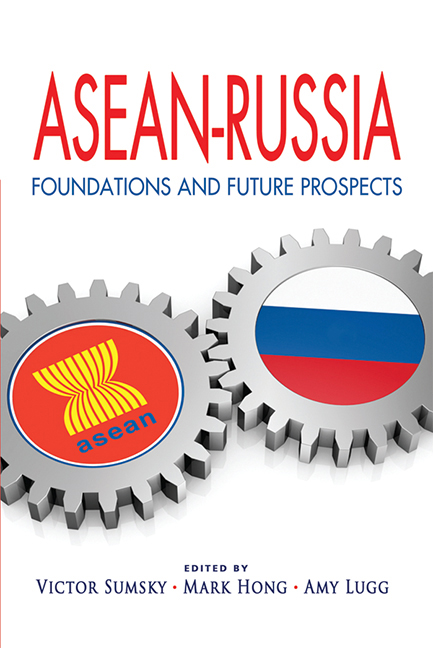Book contents
- Frontmatter
- Contents
- Foreword
- Preface
- About the Contributors
- Keynote Address
- Opening Remarks
- Keynote Address
- Introduction: Russia and the ASEAN Member States: Political and Economic Cooperation in Progress
- SECTION I WISEMEN'S VIEWS
- SECTION II GEOPOLITICS
- SECTION III BILATERAL RELATIONS
- SECTION IV Business and Economics
- SECTION V CULTURE AND EDUCATION
- EPILOGUE
- Russia's Search for an Enhanced Role in Southeast Asia
- Russia's Asian Strategy
- Index
Russia's Search for an Enhanced Role in Southeast Asia
from EPILOGUE
Published online by Cambridge University Press: 21 October 2015
- Frontmatter
- Contents
- Foreword
- Preface
- About the Contributors
- Keynote Address
- Opening Remarks
- Keynote Address
- Introduction: Russia and the ASEAN Member States: Political and Economic Cooperation in Progress
- SECTION I WISEMEN'S VIEWS
- SECTION II GEOPOLITICS
- SECTION III BILATERAL RELATIONS
- SECTION IV Business and Economics
- SECTION V CULTURE AND EDUCATION
- EPILOGUE
- Russia's Search for an Enhanced Role in Southeast Asia
- Russia's Asian Strategy
- Index
Summary
INTRODUCTION
This epilogue examines how Russia perceives Southeast Asia and the potential roles it has tried to play in the sub-region. Russia aspires to become a more significant player in the sub-region as well as in the wider Asia-Pacific region as befits its great power aspirations. This was especially the case under President Putin when foreign policy was based on pragmatism, aimed at transforming Russia into a “normal” great power through economic modernization and development, as the foundation for restoring Russia's greatness and relevance to world affairs and that of neighbouring regions, including East Asia. This foreign policy approach has generally been continued by President Medvedev. The paper will also examine the different roles Russia has tried to play in Southeast Asia.
Firstly, Russia as a “balancer” in the regional balance of power where ASEAN plays a leading role in regionalism, is a rising centre of power in a multi-polar Asia, and is seeking for other powers to help balance the growing influence of China. Secondly, the ASEAN market holds much potential for Russia's economic role in the sub-region, including through the utilization of its primary economic assets — arms and energy — and also for further expansion and diversification of economic ties, including through cooperation in science and technology. Lastly, ASEAN is a diversified entity, whose members Russia assigns different levels of priority to and holds different opportunities for Russia to play an enhanced role in Southeast Asia.
HISTORICAL OVERVIEW
Southeast Asia's significance for Russia has historically been limited. Even when Tsarist Russia's expansion into the Far East reached its peak in the latter half of the nineteenth century, it was the countries of Northeast Asia which lay next to the Russian Far Eastern territories that drew Russia's immediate attention. Southeast Asia, however, was seen as too distant for Russia's strategic interests, apart from the need to secure shipping lanes for naval and supply vessels from the Black Sea to Russia's Far Eastern port at Vladivostok, especially in light of the other European powers’ colonial expansionism in this sub-region.
- Type
- Chapter
- Information
- ASEAN-RussiaFoundations and Future Prospects, pp. 325 - 344Publisher: ISEAS–Yusof Ishak InstitutePrint publication year: 2012



